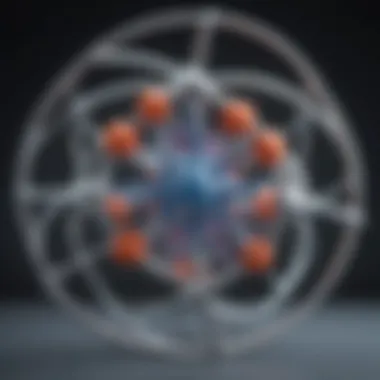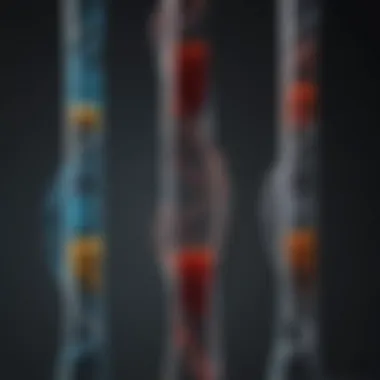CTAB DNA Extraction Buffer: Comprehensive Overview


Intro
The CTAB DNA extraction buffer has become essential in molecular biology due to its effectiveness in isolating DNA from various types of biological samples. Its widespread use stems from its ability to yield high-quality DNA, which is critical for downstream applications such as PCR, cloning, and sequencing. As researchers explore the realm of genomics, the significance of DNA extraction methods cannot be understated. CTAB, or cetyltrimethylammonium bromide, plays a pivotal role in facilitating cell lysis, thereby enabling the extraction process.
Research Context
Background and Rationale
Understanding the mechanisms behind DNA extraction is vital for researchers. CTAB buffer is known for its cationic properties, which allow it to bind to negatively charged DNA molecules. This unique interaction makes it particularly effective in breaking down complex cellular structures and releasing DNA. The rationale for utilizing CTAB lies in its ability to generate clean and intact DNA, especially from challenging samples such as plant tissues, which are often rich in secondary metabolites.
Literature Review
Numerous studies have been conducted to explore the efficacy of CTAB in DNA extraction. Research published in journals like "Molecular Biology" highlights its advantages over other extraction methods, such as phenol-chloroform extraction. In one study, CTAB was shown to produce a higher yield of DNA with minimal contamination. Such findings underline the growing preference for CTAB in various scientific inquiries. Additionally, reviews in resources like Britannica provide insights into the chemical properties of CTAB that enhance its performance in the extraction process.
Methodology
Research Design
The methodology of using CTAB DNA extraction buffer typically involves a systematic approach that includes buffer preparation, sample processing, and subsequent purification steps. Each stage is crucial for obtaining desirable DNA quality and quantity. By carefully designing the experimental workflow, researchers can optimize conditions to suit specific types of samples, whether they are animal, plant, or microbial.
Data Collection Methods
Data collection during the extraction process involves assessing both the yield and purity of the isolated DNA. Techniques such as spectrophotometry can be employed to quantify DNA concentration and evaluate the ratios of absorbance at 260 nm and 280 nm. This analysis allows researchers to determine the presence of contaminants and make informed choices about potential downstream applications.
"CTAB DNA extraction buffer remains a preferred choice among molecular biologists for its reliability and efficiency in producing high-quality nucleic acid."
Foreword to CTAB DNA Extraction Buffer
The CTAB DNA extraction buffer plays a crucial role in molecular biology. Understanding its significance is vital for researchers aiming to isolate DNA efficiently from various biological materials. Effective DNA extraction is the cornerstone of many molecular techniques. Therefore, knowing the properties of CTAB and how it enhances this process can greatly benefit experiments and subsequent analyses.
Historical Context and Development
CTAB, or cetyltrimethylammonium bromide, has been employed since the late 20th century in molecular biology laboratories. Initially, scientists needed an efficient method to extract DNA from plant tissues. Traditional methods often yielded poor results or proved too lengthy. This limitation prompted researchers to experiment with various detergents, leading to the development of CTAB-based protocols. The early adoption of CTAB simplified DNA extraction, especially from tough plant cell walls.
As time progressed, several protocols utilizing CTAB emerged. They showcased varying degrees of efficiency based on sample type. This adaptability solidified CTAB’s status in molecular laboratories globally. Today, it is considered a standard reagent for DNA extraction, demonstrating its significance in both academic and industrial research.
Importance of DNA Extraction in Molecular Biology
DNA extraction is foundational in molecular biology, facilitating numerous applications. It allows scientists to analyze genetic material, engage in cloning, and conduct PCR reactions. Without proper DNA extraction, downstream applications would struggle. The quality and integrity of extracted DNA directly impact research outcomes. Inconsistencies in yield or purity may lead to unreliable data.
Furthermore, as biotechnology evolves, the methods for DNA extraction continue to be refined. CTAB buffers have proven particularly beneficial for isolating genomic DNA from plants, fungi, and microorganisms. Moreover, their effectiveness extends to handling challenging samples, where traditional methods might fail. Thus, understanding the nuances of CTAB and its application ensures researchers employ the most suitable protocols for their specific needs.
"The realm of molecular biology hinges on the ability to extract pure DNA. CTAB stands out for its efficiency and reliability across diverse biological samples."
Composition of CTAB DNA Extraction Buffer
The composition of CTAB DNA extraction buffer is crucial for its effectiveness in isolating DNA from various biological samples. Understanding the specific elements and their functions can provide insights into optimizing the extraction process and ensuring high yields of pure DNA. Each ingredient in the buffer plays a distinct role in contributing to the overall efficiency of DNA recovery. This section outlines the primary components of the CTAB buffer and how they interact during the DNA extraction process.
Primary Ingredients and Their Functions
CTAB (Cetyl Trimethyl Ammonium Bromide) is not the only ingredient in the extraction buffer. The primary ingredients include CTAB itself, a salt, a buffer agent, and sometimes additional reagents. Each of these components has specific roles:


- CTAB: This cationic detergent binds to nucleic acids, facilitating the lysis of cell membranes and the precipitation of DNA.
- Sodium Chloride: Often used to stabilize protein-DNA interactions; it also helps in the removal of polysaccharides and proteins that can co-precipitate with DNA.
- Buffering Agent (e.g., Tris): Maintains a stable pH during the extraction process, which is essential for preserving the integrity of the DNA.
- EDTA (Ethylenediaminetetraacetic acid): A chelating agent that binds divalent metal ions, thus inhibiting nuclease activity that could degrade DNA.
By knowing the composition of the CTAB buffer, researchers can adjust concentrations and conditions tailored to specific sample types, leading to improved extraction outcomes.
Role of CTAB in Cell Lysis
CTAB serves as a critical agent in cell lysis within the DNA extraction protocol. When added to a biological sample, CTAB disrupts lipid membranes, leading to cell rupture. The positively charged CTAB molecules bind to the negatively charged phospholipids in the cell membrane. This interaction destabilizes and disassembles the membrane structure, allowing cellular contents, including DNA, to be released into the solution.
This mechanism of action is distinct from other extraction techniques. In contrast to phenol-chloroform or other methods, CTAB enables simultaneous extraction of polysaccharides when properly formulated. Moreover, CTAB's ability to precipitate DNA out of aqueous solutions is effective, making it a preferred choice for both plant and microbial samples. The soluble and insoluble forms it produces aid in isolating high-quality DNA free from contaminants.
Mechanism of Action
Understanding the mechanism of action of CTAB DNA extraction buffer is crucial for grasping its utility in molecular biology. This section details how CTAB interacts with biological materials to facilitate effective DNA extraction. Moreover, it compares CTAB's mechanisms with those of other prevalent extraction methods, underscoring key differences and advantages.
How CTAB Interacts with Biological Material
CTAB, or cetyltrimethylammonium bromide, is a cationic detergent. Its positive charge allows it to bind to negatively charged components within cells, primarily nucleic acids and cell membranes. During the extraction process, CTAB disrupts cellular membranes, promoting the lysis of cells and the release of DNA.
When CTAB penetrates the cell membrane, it interacts with phospholipids in the lipid bilayer. This interaction leads to the solubilization of membrane components and facilitates the release of intracellular materials, including nucleic acids. CTAB also helps to precipitate polysaccharides, which may co-purify with DNA, allowing for a cleaner final product.
Moreover, CTAB has a role in stabilizing the released DNA. Its binding affinity assists in preventing degradation through enzymatic reactions. This stability minimizes loss of yield during the extraction process, which is critical for downstream applications.
CTAB can also selectively precipitate DNA while leaving other cellular components in solution, thus enhancing the purity of the extracted DNA.
Comparison With Other Extraction Methods
In evaluating CTAB's effectiveness, a comparison with other extraction methods reveals its distinguishing features and benefits.
Phenol-Chloroform Extraction
Phenol-chloroform extraction involves the use of organic solvents to separate nucleic acids from proteins and other cellular debris. One key aspect of this method is its ability to achieve high purity of nucleic acids. The phenol phase effectively denatures proteins, while the aqueous phase retains nucleic acids.
However, this method can have drawbacks, including the handling of hazardous chemicals and the potential for co-extraction of phenolic compounds that can inhibit PCR. While it can be a popular choice for certain applications due to its high recovery rates, the complex process and safety concerns make it less favorable in some labs.
Silica Gel Methods
Silica gel methods utilize the ability of silica to adsorb DNA in the presence of chaotropic agents. This technique is straightforward and can yield high-quality DNA. The key characteristic of this approach is its efficiency and speed. Silica methods reduce the time needed for extraction significantly compared to traditional methods.
The unique feature here lies in the ease of purification. However, silica methods may not be as effective for samples containing high amounts of polysaccharides, which can inhibit DNA binding. Therefore, while they are beneficial for many standard applications, they might not be the best choice in scenarios involving complex plant tissues.
Alkaline Lysis Techniques
Alkaline lysis techniques focus on the use of alkaline conditions to lyse cells, accompanied by neutralization steps to precipitate plasmid DNA. An essential advantage of this method is the rapid processing. It allows both plasmid DNA extraction and is particularly useful for bacterial samples.
However, this approach is limited primarily to plasmid extraction and may not perform well with genomic DNA from eukaryotic cells. The method can also lead to contamination with genomic DNA if not conducted correctly.
In summary, while CTAB exhibits specific advantages in terms of DNA yield and purity for a variety of biological samples, it is critical to consider the context in which it is used relative to other established extraction techniques. Each method has its own merits and limitations, making it vital for researchers to select an extraction method that aligns with their experimental objectives.
Application Areas of CTAB DNA Extraction Buffer
The application areas for the CTAB DNA extraction buffer highlight its versatility in molecular biology. Various biological samples require different extraction methodologies, and the CTAB buffer excels in many settings. It provides a reliable means of obtaining high-quality DNA for a range of applications, including genetic analysis, cloning, and sequencing. The effectiveness of CTAB in diverse samples, including plants, microbes, and animal tissues, reflects its significance in any laboratory environment engaged in DNA extraction.
Genomic DNA Isolation in Plants


One of the most prevalent applications of CTAB DNA extraction buffer is in the isolation of genomic DNA from plant tissues. Plants present unique challenges due to the presence of cellulose and other polysaccharides in their cell walls. CTAB facilitates lysis, separating the DNA from these components efficiently.
- Cell Lysis: The cationic nature of CTAB helps to dissolve cell membranes, allowing for the release of DNA. This is vital for the successful isolation of high-purity genomic DNA.
- Removal of Contaminants: CTAB's properties also help to precipitate polysaccharides and phenolic compounds that can inhibit downstream applications.
- Yield and Quality: Extracted DNA is often of high yield and quality, making it suitable for PCR, sequencing, and other genetic studies in plant biology.
In many studies, researchers have demonstrated that CTAB extraction leads to superior DNA integrity compared to other solvents, enhancing the reliability of the results in genetic analyses.
CTAB in Microbial DNA Extraction
CTAB is also widely utilized for the extraction of DNA from bacterial and fungal cells. The complexity of microbial cell walls varies greatly, often requiring tailored extraction solutions. CTAB meets this need through its flexible protocols.
- Efficiency: The buffer has been shown to provide high-quality DNA, even from challenging sources such as soil microbes or biofilms.
- Application Scope: Since microbial DNA is often required for environmental studies or biotechnology applications, CTAB's versatility makes it essential in these fields.
- Protocol Customization: Different strains may require adjustments in the protocol, illustrating CTAB's adaptability across various microbial species.
These advantages underscore its importance for researchers engaged in microbiological research or genetic engineering involving microorganisms.
Utilizing CTAB for Animal Tissue Samples
CTAB's application extends beyond plants and microbes. It is beneficial in extracting DNA from animal tissues as well. While other methods may face limitations, CTAB proves effective for a wide range of mammalian and non-mammalian tissues.
- Tissue Homogenization: CTAB helps disrupt both fibrous and greasy tissues, ensuring comprehensive cell lysis.
- High Yield: The use of CTAB typically results in a high yield of genomic DNA, suitable for applications like genotyping or phylogenetic studies.
- Versatility: The protocol can be adjusted according to the type of sample, from soft tissues like liver to harder structures like bones.
This flexibility is particularly valuable in evolutionary biology, forensic science, and medical research, where different types of specimens are common. By harnessing CTAB, researchers can obtain reliable and high-quality DNA across various animal samples.
In summary, the application of CTAB DNA extraction buffer demonstrates its pivotal role in molecular biology, bridging significant gaps in the extraction process of diverse biological materials. The adaptability of the buffer provides an essential tool for research practitioners seeking to obtain high-quality DNA efficiently.
Considerations for Optimizing CTAB DNA Extraction
Optimizing CTAB DNA extraction requires attention to several key factors. This section discusses essential considerations that impact both the yield and purity of extracted DNA. Understanding these factors enhances the efficacy of the extraction process, making it more reliable across different biological samples.
Factors Influencing DNA Yield and Purity
Sample Type
Sample type is a critical aspect that influences DNA yield and purity. Different biological materials contain unique cellular structures and compositions. Plant tissues, for instance, often have high levels of polysaccharides and polyphenols, which can complicate DNA extraction. These compounds can co-purify with the DNA, leading to contamination and decreased yield. Therefore, careful selection of sample type is crucial; using young leaves typically yields cleaner DNA due to a lower concentration of these interfering substances. The choice of sample also affects the lysis efficiency of CTAB; softer tissues generally disrupt easier and provide more DNA.
Extraction Protocol Variations
Extraction protocol variations play an important role in the effectiveness of CTAB DNA extraction. Protocols may differ in the concentration of CTAB used, the presence of additives like PVP (Polyvinylpyrrolidone), and the specific steps employed in the process. A variation that includes a high concentration of CTAB may significantly enhance cell lysis, leading to higher yields. However, implementing too many changes without validation can lead to inconsistent results. Thus, adjusting protocols must be systematic and carefully considered. Customizing extraction methods based on the material being processed often yields the best results.
Incubation Times
Incubation times during the extraction process also contribute to overall success. Lengthening incubation periods can improve the lysis of tough tissues but risks potential DNA degradation if the period is excessive. Finding the right balance is essential. For example, a 30-minute incubation at optimal temperatures can maximize yield without compromising DNA integrity. Shorter incubations may work well for delicate tissues, while longer times could benefit more fibrous samples. Ultimately, individual experimentation with incubation times can lead to improved results tailored to specific requirements.
Storage Conditions for DNA Samples
Proper storage conditions are vital for maintaining the integrity of extracted DNA. Following extraction, samples should be stored at low temperatures to prevent degradation. Ideally, samples are kept at -20°C or -80°C for long-term storage. It is essential to use appropriate buffers and containers, such as sterile microcentrifuge tubes, to minimize contamination risks. Additionally, avoiding repeated freeze-thaw cycles is critical. Such practices significantly enhance the longevity and viability of DNA samples, ensuring they are ready for subsequent analysis when needed.
Troubleshooting Common Issues
Troubleshooting common issues in DNA extraction using CTAB buffer is essential for achieving optimal results. Researchers often encounter challenges that can impact the yield and quality of the extracted DNA. Understanding these issues enhances the overall efficiency of molecular biology experiments and ensures that findings are reliable. Moreover, managing potential pitfalls in the extraction process saves time and resources, which is crucial in research settings. Below, we explore specific problems and their solutions.
Low DNA Yield Problems
Low DNA yield is a frequent concern when using CTAB for extraction. Several factors might cause this issue. First, the choice of plant tissue can significantly impact yield. Some materials, like young leaves, may have higher yields compared to older or woody samples. Inadequate disruption of the tissue can also lead to low yields. Proper grinding methods or using liquid nitrogen to freeze the samples before extraction can help.


Additionally, the incubation time in the CTAB buffer is critical. Too little time may not allow sufficient lysis of the cells. Typically, a period of around 30 minutes is recommended, but this can vary based on sample type. It's useful to monitor the extraction protocol to find the best timing for specific samples.
Another factor is the concentration of CTAB. If the concentration is too low, it may not effectively disrupt cellular structures. Conversely, excessively high concentrations may precipitate proteins along with the DNA. Tuning the CTAB concentration according to the sample type can help achieve the best yield.
Contamination Challenges
Contamination can hinder the purity of DNA extracted with CTAB. This problem can arise from various sources, including cross-contamination of samples or the presence of residual reagents. To minimize contamination, it's important to use sterile tools and clean workspaces. Ensure that all glassware and plasticware are adequately autoclaved or treated with disinfectants.
Additionally, the design of the extraction protocol should include a cleanup step, such as phenol-chloroform extraction or ethanol precipitation, if necessary. These steps ensure removal of any residual contaminants, particularly proteins that may co-extract with the DNA.
It's also vital to implement controls in experiments. Running blank samples can help identify contamination sources, allowing for necessary adjustments in the protocol.
Degradation of DNA Samples
DNA degradation is another serious issue after extraction. Various factors contribute to this, including inappropriate storage conditions and enzymatic activity. The stability of DNA is highly sensitive to temperature and time. Samples should be stored at -20 degrees Celsius or colder to prevent degradation over time.
Furthermore, the presence of nucleases can lead to rapid breakdown of DNA. Contamination with RNases is a common concern, as these enzymes can also act on DNA. Using RNase inhibitors during the extraction process can help prevent degradation.
To mitigate degradation, regular quality checks on DNA samples should be conducted using agarose gel electrophoresis. This allows researchers to ascertain the integrity of their DNA and determine if it is suitable for downstream applications.
Future Directions in DNA Extraction Technologies
The exploration of future directions in DNA extraction technologies holds significant importance in the realm of molecular biology. As research continues to evolve, the demand for more efficient, reproducible, and accessible methodologies becomes critical. This section discusses emerging trends, technological advancements, and the implications for various sectors dependent on DNA extraction processes.
Emerging Trends in Extraction Buffers
Recent advancements in the formulation of extraction buffers are noteworthy. Researchers are increasingly focused on modifying existing buffers to enhance efficiency and reduce costs. For example, there is a growing interest in developing green extraction buffers that are environmentally friendly. These buffers aim to minimize the use of harmful chemicals while maintaining optimal efficiency.
Key points in this trend include:
- Biodegradability: Emerging extraction buffers are being designed for biodegradability, reducing waste and harm to the environment.
- Increased Yield: New formulations aim to improve DNA yield, making applications more effective in various biological contexts, including plants and animals.
- Cost-Effectiveness: Developing cost-effective solutions is vital for laboratories with budget constraints. This trend supports wider accessibility of advanced techniques across different research settings.
Moreover, bio-based buffers, made from naturally occurring substances, are gaining traction. They present an attractive alternative, as they can be tailored specifically for various organism types.
Integration of Automation in DNA Extraction
Automation in DNA extraction is becoming more prevalent as laboratories seek to enhance throughput and reduce human error. The integration of robotics and automated systems facilitates efficient handling of samples, reduces manual intervention, and allows for higher consistency across experiments.
Benefits of introducing automation:
- Improved Throughput: Automated systems can process a larger number of samples simultaneously, a key factor in high-throughput settings like genomics centers.
- Standardization: Automation minimizes variability between experiments, yielding more reproducible results which is crucial in intricate analyses.
- Labor Savings: By automating routine tasks, researchers can allocate their time to more complex experimental designs and analyses, maximizing productivity.
Although the initial investment in automation can be high, the long-term benefits often outweigh the costs, particularly in research environments requiring consistent results and efficiency. As technology continues to advance, further refinements in robotic systems and software will make automation increasingly accessible.
"The future of DNA extraction is not just in the technique but in the tools that make the process more efficient and less error-prone."
Summary
The significance of summarizing key takeaways in this article cannot be understated. This section condenses critical concepts surrounding CTAB DNA extraction buffer, allowing readers to revisit the essential points without sifting through the entire content. A concise summary serves not just as a reflection of the entire discussion but also as a tool for readers to gauge the depth of the material presented.
Among the various aspects addressed, the composition of the buffer stands out. Understanding the primary ingredients, specifically CTAB, is crucial. This knowledge aids in appreciating how the buffer operates in practical applications. Studies show that the effectiveness of CTAB is highlighted in processes involved in DNA isolation from plant, animal, and microbial cells.
Moreover, the mechanisms of action that underlie CTAB's efficiency offer insights into its comparative advantages over alternative DNA extraction methods. The emerging trends and troubleshooting tips discussed earlier make this buffer a reliable choice in molecular biology labs worldwide.
This summary is a roadmap of sorts for practitioners. It encourages them to reflect on the challenges and considerations outlined in previous sections, ultimately reinforcing the articles’ contributions to enhancing DNA extraction practices. Ensuring that maximum yield and purity can be attained, the points recapped here form a robust basis for future explorations in the realm of genetic research.
Key Takeaways
- CTAB's Role: The primary component responsible for lysis and subsequent DNA extraction process.
- Comparative Advantage: CTAB buffer shows significant benefits when compared to phenol-chloroform and silica gel methods.
- Practical Application: Versatile in various biological samples, including those from plants, animals, and microorganisms.
- Optimization Considerations: Factors such as sample type and storage conditions play a vital role in the success of extraction.
- Future Exploration: Emerging technologies are poised to enhance extraction efficiency further.



